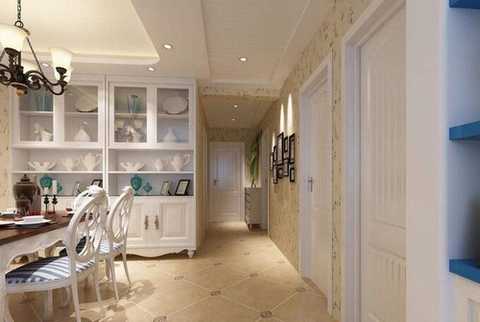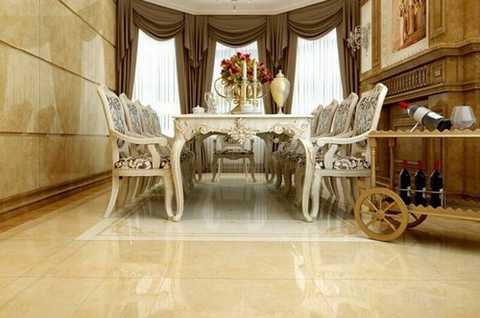Tiles are the most common and indispensable building materials in modern decoration. Tiles also play a pivotal role in home decoration. There are many kinds of tiles and different characteristics. Many owners will encounter problems in the decoration. Today, Xiaobian will introduce the knowledge of the type, material, size, selection and laying of tiles.

1. What are the types of tiles?
Nowadays, there are a lot of ceramic tiles on the market, it is not easy to choose, and the first step you should do is to figure out what kinds of common tiles are.
Polished brick
After mechanical grinding and polishing, the surface is mirror-glossy ceramic tiles. Due to the high brightness of the surface after polishing, it is fresh and clean after being laid, and it is easy to handle.
Matt brick
The surface is dull or the gloss is low. Compared with the glossy brick, the surface gloss is soft, and the retro brick is mostly matt glazed.
Glazed brick
Glazed ceramic tiles. According to the water absorption rate of the green body, porcelain glazed tiles and ceramic glazed tiles (commonly known as porcelain tiles) are commonly used. Because of the glassy glaze on the surface, it has good anti-fouling properties and is easy to care for. It is often used in kitchen and bathroom walls.
Microcrystalline brick
The surface is covered with a layer of glass-ceramic dry glaze, and the polished surface is mirror-glossy. Due to the crystal clear surface of the microcrystalline layer, the decorative effect presents a magnificent high-end effect, and the high-end villas and hotel walls are used more.
Glazed brick
It is also called polished glazed brick and fully polished glazed brick. It is a kind of ceramic tile which is coated with a layer of polished glaze on the glazed printing process of glazed tiles and polished by mechanical polishing. The glaze is as smooth and polished as polished tiles, while its rich pattern is rich.
Vitrified brick
It refers to the customary term for water absorption of 0.5% porcelain bricks, usually referred to as polished tiles.
Porcelain throwing brick
A porcelain brick having a high-temperature porcelain property coated on the surface of the dry-formed blank, the surface of which is a porcelain material, which is printed and decorated, sintered at a high temperature, and micro-polishing/grinding on the surface. Compared with ceramic wall tiles whose surface is made of vitreous material (such as glazed polished brick, polished crystal brick, etc.), it has higher wear resistance, thick and warm texture, more natural and realistic texture, and reproduces the texture and texture of natural stone. It can replace natural stone and is suitable for interior and exterior decoration of various buildings. It can be widely used for wall decoration of high-end properties.

2. What is the material of the tile?
The material of the tile is from the perspective of water absorption, such as porcelain brick, enamel tile, fine brick, ceramic tile and the like.
The porcelain brick structure is compact, the water absorption rate is low, the knocking sound is crisp and loud, and it is customary to call it a vitrified brick; while the ceramic brick structure is porous, the water absorption rate is high, and the knocking sound is dull. In general, the price of porcelain tiles is higher than that of ceramic tiles.
Porcelain throwing bricks are made of all-ceramic materials from the body to the surface. The density is high, with the superior performance of traditional polished tiles, and the rich decorative effect of glazed tiles and glazed tiles. The texture of porcelain throwing bricks can be varied and varied, and can express various design languages ​​as desired, fully satisfying the individualized decorative needs of consumers, and the decorative effect is close to natural stone.
3, the size and thickness of the tile
The specifications and thickness of the tiles on the market are diverse, square and rectangular, and the effects of each type of tile are also different. If you want to get the ideal decoration effect and save costs, you must know the size and thickness of the tile before buying the tile.
Living room floor tile
Common specifications are 60*60cm, 80*80cm, 100*100cm, 60*90cm, 60*120cm, and the new high-grade porcelain throwing bricks are now 90*90cm;
Kitchen and floor tiles
Common specifications are 15*15*, 30*30cm, 35*35cm, 40*40cm, etc.
Kitchen wall tile
Common porcelain specifications are 15*15cm, 30*45cm, 30*60cm, 35*75cm, 24*66cm, 40*80cm, etc. Nowadays, it is also popular to use porcelain tiles to cut the upper wall. Common cutting specifications are 30*60cm, 40*80cm, 30*90cm and so on.
Common tile thickness
60*60cm tile about 10mm
80*80cm tile about 11mm
After understanding the specifications of the tiles, how do you choose the tile specifications according to the characteristics of your house? In fact, as long as you consider four aspects, the problem will be solved:
1 consider the size of the room
If the area of ​​the room is small, try to use smaller specifications. Otherwise, use larger specifications.
2 consider how much furniture
If there are many places covered by furniture, the visible area of ​​the ground is small, and small-sized floor tiles should be considered, and vice versa.
3 consider the space length and width
It is better to use all the tiles in the whole tile. Try not to cut bricks or cut less, and reduce waste.
4 consider budget issues
In general, for the same series of products of the same brand, the larger the brick size, the higher the price.
After the tile specifications are selected, how do you calculate the tile usage?
(planned tiling area ÷ each tile area) × 1.05 = number of tiles required (some loss is considered)

4, tile selection pay attention to eight items
After you have determined the type of tile you want to buy, you can go to the store to buy it. How can you know what kind of tile quality is good or bad in the process of selection? This should be carefully considered and selected from the following eight aspects:
Look: the color uniformity of the brick, the surface finish, check for defects such as chromatic aberration, deformation, lack of edges and corners.
Knocking: Lightly hit the brick with a hard object. The crisper the sound, the higher the vitrification and the better the quality.
Drip: Drop the water droplets on the back of the tile. If it is absorbed quickly, it means that the body has many pores and high water absorption. On the contrary, the body is dense and the water absorption rate is low.
Amount: Use a tape measure to measure the size of each tile, and the accuracy is high.
Draw: Use a normal blade to wipe the surface of the brick hard, leaving no scratches on the surface, indicating that the brick has strong wear resistance.
Pressure: The tiles are suspended and the people stand on the tiles. If the tiles are basically not damaged or cracked, the bearing capacity is good.
Fell: A good tile will not break after going straight through the vertical.
It is said that a good tile has a high density, a heavy weight, a relatively solid thickness, a uniform thickness, and a relatively poor quality tile.
5, the performance of common tiles and natural marble
The advantages of porcelain throwing bricks are more comprehensive. What are the characteristics?
1. Warm texture
The new porcelain surface material makes the porcelain surface warm and heavy, and the surface fabric is similar to natural granite, but it is superior to ordinary stone in material hardness and acid resistance.
2. Imitation stone texture
The permeable inkjet ink introduces a color-assisting material into the fabric, and the digital inkjet infiltration process gives a three-dimensional realistic texture.
3. Whole body texture
Porcelain throwing brick adopts a new decorative technique and method, and develops a one-piece fabric technology to make the product have a sense of appearance.
4. Wear and stain resistance
Through the use of new materials, porcelain throwing bricks have higher wear resistance and stain resistance than ceramic wall tiles whose surface is made of vitreous materials (such as glazed polished tiles, polished crystal tiles, etc.).
6, the common method of tile laying
Three points depend on quality, and seven points depend on paving. Good ceramics are very important, but relatively, with high-quality ceramic tiles, poorly laid, it will waste bricks.
Dry-laid method (generally suitable for paving large-scale floor tiles)
After the base layer is watered and moistened, sand and debris are removed. Wipe the bonding layer, use one to three dry hard cement mortar, level the paving according to the horizontal line, put the brick on the mortar and use the rubber hammer to tap, remove the floor brick and apply the cement slurry, and then level the floor bricks. The dry-laid method effectively avoids the occurrence of bubbles, hollow drums and the like.
Wet shop method (for upper wall or small size floor tiles)
This difference from the dry-laid method is to replace one to three dry cement mortars with ordinary cement mortar.
The tile floor with wet-laid method may produce empty drums and air bubbles, and attention should be paid to the construction quality. However, due to the simple operation and low price of the wet-laying method, many families still use the wet-laid method to lay the ground (usually only for the ground). Spread a small size).
Tile adhesive plastering
Porcelain bricks (porcelain throwing bricks, vitrified bricks, microcrystalline bricks, glazed polished bricks, polished tiles) have low water absorption and heavy weight. The upper wall cannot be directly paved with cement mortar, otherwise it will easily fall off. Nowadays, the popular paving method is to use tile adhesive (also called tile adhesive and tile adhesive. After the base layer is processed, apply tile adhesive on the wall or floor, then scrape it into strips with a serrated scraper, and then Apply the tile adhesive on the back of the brick and scrape it into strips. Then attach the brick to the wall and tap it. This method is fast and firm.
Hanging method
For large-size or thick-thick porcelain tiles, due to their heavy weight and high density, they should be constructed with a more reliable hanging method. Compared with the traditional dry hanging method, the hanging method has low cost and simple operation, and is widely applicable to interior decoration. The hanging method is to cut the chute on the back of the tile with a special slotting machine or a manual cutter, then insert the special pendant into the chute, and then stick the pendant with marble glue or AB glue, then the back of the brick Apply tile adhesive and normal construction. This method can effectively prevent the late fall off, and is a relatively safe construction method.
Xiaobian warm reminder:
Tiles are indispensable decorative materials for today's wall decoration, but you must fully learn the type, material and size of the tiles, price and other knowledge before purchasing, in order to select the right tiles. At the same time, to understand more about the laying method of ceramic tiles, it is also conducive to better supervision and grasp of the entire process of decoration construction.
Silicone Keypads, Known as Rubber Keypad, Elastic Silicone Keyboard, Keypad Keyboard Cover etc, which mainly made of elastomeric transparent silicone rubber materials by silicone rubber compression molding tooling.
Keypad Web & Wall, Key Pad, Key Top & Cover and Electrically Conductive Contact Zones that consist of Silicone Rubber Keypad major structure.
Rubber Keypads ,Custom Rubber Keyboard ,Custom Rubber Keypads ,Silicone Button Pad
Xiamen The Answers Trade Co.,Ltd. , https://www.xmanswer.com